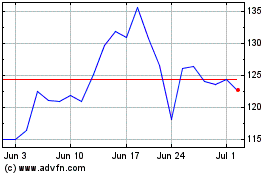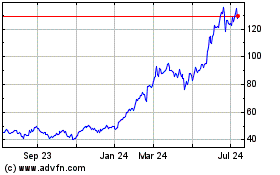NVIDIA Turbocharges Extreme-Scale AI for Argonne National Laboratory’s Polaris Supercomputer
August 25 2021 - 7:00AM

The largest GPU-based supercomputer at the U.S. Department of
Energy’s Argonne National Laboratory will run on NVIDIA’s
accelerated computing platform, the company announced today.
The Polaris supercomputer, hosted at the laboratory’s Argonne
Leadership Computing Facility (ALCF), will supercharge research and
discovery with extreme scale for users’ algorithms and science.
Accelerated by 2,240 NVIDIA® A100 Tensor Core GPUs, the system can
achieve almost 1.4 exaflops of theoretical AI performance and
approximately 44 petaflops of peak double-precision
performance.
Polaris, to be built by Hewlett Packard Enterprise, will combine
simulation and machine learning by tackling data-intensive and AI
high performance computing workloads, powered by 560 total nodes,
each with four NVIDIA A100 GPUs.
“The era of exascale AI will enable scientific breakthroughs
with massive scale to bring incredible benefits for society,” said
Ian Buck, vice president and general manager of Accelerated
Computing at NVIDIA. “NVIDIA’s GPU-accelerated computing platform
provides pioneers like the ALCF breakthrough performance for
next-generation supercomputers such as Polaris that let researchers
push the boundaries of scientific exploration.”
“Polaris is a powerful platform that will allow our users to
enter the era of exascale AI,” said ALCF Director Michael E. Papka.
“Harnessing the huge number of NVIDIA A100 GPUs will have an
immediate impact on our data-intensive and AI HPC workloads,
allowing Polaris to tackle some of the world’s most complex
scientific problems.”
The system will accelerate transformative scientific
exploration, such as advancing cancer treatments, exploring clean
energy and propelling particle collision research to discover new
approaches to physics. And it will transport the ALCF into the era
of exascale AI by enabling researchers to update their scientific
workloads for Aurora, Argonne’s forthcoming exascale system.
Polaris will also be available to researchers from academia,
government agencies and industry through the ALCF’s peer-reviewed
allocation and application programs. These programs provide the
scientific community with access to the nation’s fastest
supercomputers to address “grand challenges” in science and
engineering.
About NVIDIANVIDIA’s (NASDAQ: NVDA) invention
of the GPU in 1999 sparked the growth of the PC gaming market and
has redefined modern computer graphics, high performance computing
and AI. The company’s pioneering work in accelerated computing and
artificial intelligence is reshaping trillion-dollar industries,
such as transportation, healthcare and manufacturing, and fueling
the growth of many others. More information at
https://nvidianews.nvidia.com/.
For further information, contact:Alex
ShapiroNVIDIA Corporation+1-415-608-5044ashapiro@nvidia.com
Certain statements in this press release including, but not
limited to, statements as to: the Polaris supercomputer running on
NVIDIA’s accelerated computing platform, being built by Hewlett
Packard Enterprise, and its impact, performance and availability;
the benefits, impact, and performance of our products and services,
including NVIDIA’s accelerated computing platform and NVIDIA A100
Tensor Core GPUs; the Polaris supercomputer supercharging research
and discovery with extreme scale for users’ algorithms and science;
and the era of exascale AI enabling scientific breakthroughs with
massive scale to bring benefits for society are forward-looking
statements that are subject to risks and uncertainties that could
cause results to be materially different than expectations.
Important factors that could cause actual results to differ
materially include: global economic conditions; our reliance on
third parties to manufacture, assemble, package and test our
products; the impact of technological development and competition;
development of new products and technologies or enhancements to our
existing product and technologies; market acceptance of our
products or our partners' products; design, manufacturing or
software defects; changes in consumer preferences or demands;
changes in industry standards and interfaces; unexpected loss of
performance of our products or technologies when integrated into
systems; as well as other factors detailed from time to time in the
most recent reports NVIDIA files with the Securities and Exchange
Commission, or SEC, including, but not limited to, its annual
report on Form 10-K and quarterly reports on Form 10-Q. Copies of
reports filed with the SEC are posted on the company's website and
are available from NVIDIA without charge. These forward-looking
statements are not guarantees of future performance and speak only
as of the date hereof, and, except as required by law, NVIDIA
disclaims any obligation to update these forward-looking statements
to reflect future events or circumstances.
© 2021 NVIDIA Corporation. All rights reserved. NVIDIA and the
NVIDIA logo are trademarks and/or registered trademarks of NVIDIA
Corporation in the U.S. and other countries. Other company and
product names may be trademarks of the respective companies with
which they are associated. Features, pricing, availability and
specifications are subject to change without notice.
NVIDIA (NASDAQ:NVDA)
Historical Stock Chart
From Mar 2024 to Apr 2024

NVIDIA (NASDAQ:NVDA)
Historical Stock Chart
From Apr 2023 to Apr 2024
